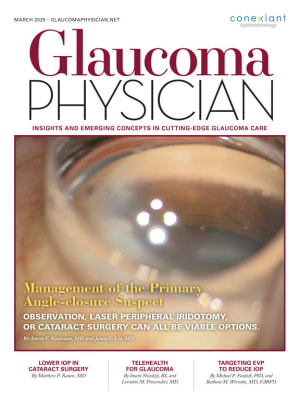Features
Management of the Primary Angle-closure Suspect
Observation, laser peripheral iridotomy, or cataract surgery can all be viable options.
By Ameay V. Naravane, MD, James C. Liu, MD
Lower IOP in Cataract Surgery
Migrating to more physiologic intraocular pressures during surgery improves chamber stability, recovery, and patient comfort.
By Matthew P. Rauen, MD
Telehealth for Glaucoma
For some underserved patients, telehealth may present a viable option for managing their disease without compromising clinical outcomes.
By Imani Nwokeji, , Lorraine M. Provencher, MD
Targeting Episcleral Venous Pressure to Reduce IOP
By directly targeting distal outflow and EVP, ATP-sensitive potassium channel openers like QLS-111 could redefine treatment.
By Michael P. Fautsch, PhD, Barbara M. Wirostko, MD, FARVO
Advocating for Preservative-free Glaucoma Drops
The Preservative Freedom Coalition wants physicians and patients to understand how preservative-free medications can improve ocular surface health.
By Jim Gallagher, senior managing editor
Web Exclusives
New Developments in Medical Therapy
Sustained-release strategies and drugs that target episcleral venous pressure hold promise for the future of glaucoma management.
By Lauren S. Blieden, MD, Bac T. Nguyen, MD
Phacoemulsification at Physiologic IOP: Benefits and Limitations
Higher pressures may be appropriate in some cases, but performing cataract surgery at lower IOP may lead to better patient outcomes.
By Shivani S. Kamat, MD, Mohamed R. Mohamed, MD
AGS Recommends Cautious Approach to Nicotinamide
Although nicotinamide, an over-the-counter supplement, remains intriguing as a potential neuroprotective agent for glaucoma, more research is needed to verify its long-term safety at higher doses.
By Jim Gallagher, senior managing editor
Departments
From the Editor: Risk Estimation Errors in Glaucoma Treatment
By Nathan M. Radcliffe, MD
Spotlight: Innovative Device Targets Eye Pressure Without Surgery or Meds
The FYSX Ocular Pressure Adjusting Pump is the first nonpharmacological, nonsurgical glaucoma treatment approved by the FDA.
By Karen Appold, contributing writer
Coding: The Growth Rate of MIGS Within Part B Medicare
A decade of rapid growth of MIGS may attenuate with more regulation.
By Kevin J. Corcoran, COE, FNAO
News
Ultrathin Shunt Shows Promising Results in Trial
In interim data presented at AGS, the VisiPlate glaucoma drainage device demonstrated significant IOP and medication reductions with a favorable safety profile.
By Jim Gallagher, senior managing editor
Restoring Access to Uveoscleral Outflow
Two-year data from the CREST trial, presented at AGS, shows a statistically significant reduction in IOP and medications.
By Jim Gallagher, senior managing editor
Alcon Introduces Voyager DSLT at AGS
The automated Nd:YAG laser for direct selective laser trabeculoplasty is now commercially available in the United States.
By Nathan M. Radcliffe, MD
MIGS Effective for Black Patients
Minimally invasive glaucoma surgeries can lower IOP effectively even among Black patients, who typically have more advanced disease.
By LEON W. HERNDON, MD
Innovative Goggles Offer Drug-free IOP Control
The FYSX Ocular Pressure Adjusting Pump is the first nonpharmacological, nonsurgical glaucoma treatment approved by the FDA.
By Nathan M. Radcliffe, MD
Six-year LiGHT Data Reviewed at AGS
The landmark study found that early SLT provides effective pressure control with less disease progression and fewer surgeries.
By Jim Gallagher, senior managing editor
Nicox Releases NCX 470 Data
Results of a post hoc analysis of the Mont Blanc trial, reported at AGS, found that the investigational drug formulation compared favorably to latanoprost.
Laser-Titratable Shunt Shows Promise in Feasibility Study
Three-month data presented at AGS suggests the Calibreye system may offer significant IOP and medication reduction with potential for in-office adjustments as needed.
By Jim Gallagher, senior managing editor
Green Strategies for Glaucoma Surgery
Thoughtful choices in the operating room can make health care more environmentally and economically sustainable.
By Jim Gallagher, senior managing editor
Epigenetic Markers May Predict Glaucoma Progression
A recent study finds that epigenetic age acceleration is linked to worsening disease.
By Jim Gallagher, senior managing editor









